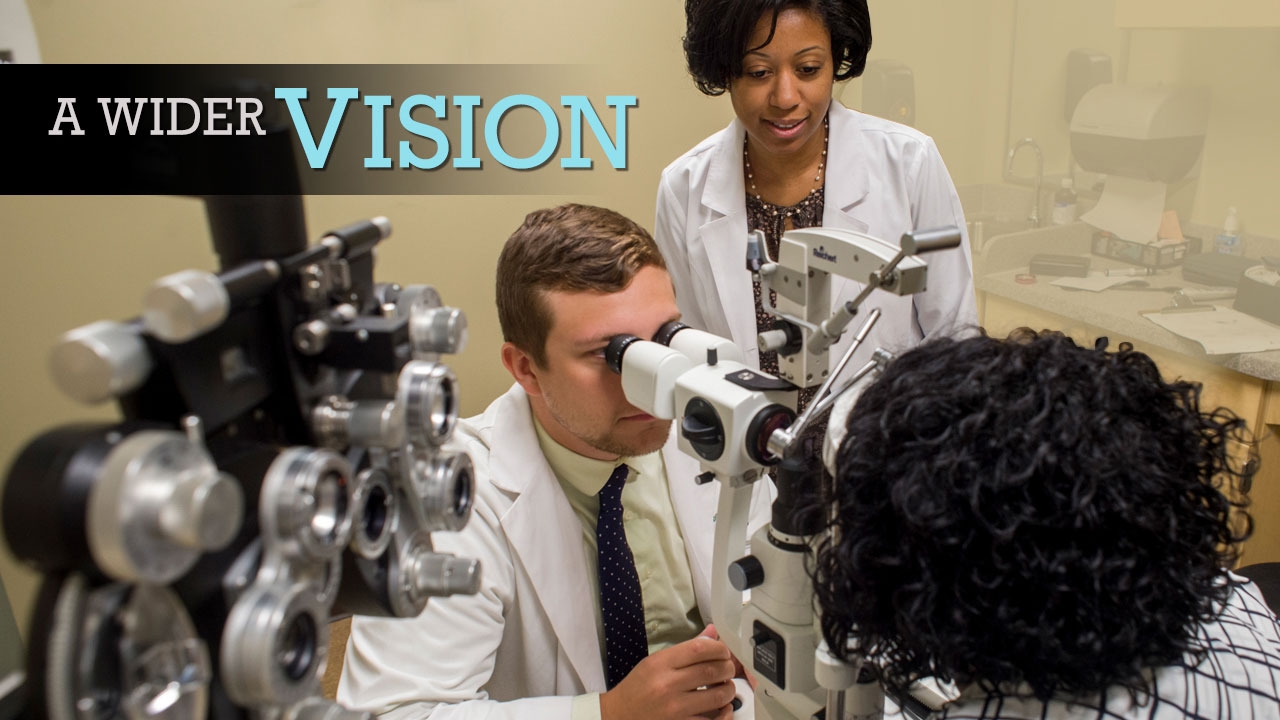Mark Whittington, a third-year student in the UAB School of Optometry, admits that sometimes he loses sight of the reasons he chose his career path. “It’s easy to fall into routines of worrying about the next assignment or test and slowly lose perspective,” he says. But each week he has a chance to regain his motivation—by looking into the eyes of people facing the challenges of poverty, homelessness, drug and alcohol addiction, disease, disability, and other issues.
Through Community Eye Care (CEC), the school’s outreach program, students—along with faculty and staff—step away from campus to provide vision services to underserved patients who otherwise would not receive it. Each year, in fact, they care for thousands of men, women, and children at little to no cost. Whittington, of Charleston, West Virginia, calls CEC “a unique opportunity to help others while continuing to gain experience. The program provides a wide range of patient age, ethnicity, and socioeconomic background that is hard to mimic in any traditional setting.”
 Caring for underserved patients provides career inspiration for (left to right) Mark Whittington, Jenaye DeRoche, and Lauren Spencer. (At top) UAB clinical assistant professor Alexia Vaughan, O.D., watches as an optometry student conducts an eye exam at Western Health Center.
Caring for underserved patients provides career inspiration for (left to right) Mark Whittington, Jenaye DeRoche, and Lauren Spencer. (At top) UAB clinical assistant professor Alexia Vaughan, O.D., watches as an optometry student conducts an eye exam at Western Health Center.Week to Week
Launched 40 years ago, CEC has evolved to become a requirement for all UAB optometry students during their second and third years. The students fan out across central Alabama, visiting local shelters and clinics, schools, senior centers, and community events. CEC operates a clinic within the Jefferson County Department of Health’s Western Health Center in Midfield; program participants also make regular visits to the School of Nursing’s PATH Clinic and its clinic at The Foundry in Bessemer, the Lovelady Center in East Lake, and United Cerebral Palsy of Greater Birmingham’s Adult Day Program at LincPoint in Homewood. In addition, CEC partners with other UAB programs to provide care to communities throughout Alabama’s Black Belt region.
“My group goes to the PATH Clinic every Thursday,” says Jenaye DeRoche, a third-year student from Houma, Louisiana. “We work alongside other health-care professionals to provide eye care to patients with diabetes who may not have any insurance. Throughout the semester we also take two to three Saturdays and go to various rural places in Alabama to provide exams to patients who would otherwise have to travel extensive distances for eye care.”
DeRoche says her role changes from week to week, ranging from adult or pediatric screenings to comprehensive eye exams, depending on the setting.
“At each location we generally work in groups of six to eight, with one student designated as the captain for that week,” Whittington notes. “The captain delegates tasks to other group members and makes sure everyone works efficiently to ensure we provide the best care to the greatest number of people.” The weekend events often involve 15 to 20 students, who see about 60 to 80 patients in a day, he adds.
Life-Changing Gift
Lauren Spencer, from Union, Kentucky, also is a third-year student. She has been involved in screenings at nursing homes, Jefferson County schools, adult-care centers, and Birmingham-area businesses in addition to providing eye exams at the clinics. Last fall, she participated in CEC’s largest event, the Gift of Sight program, which provides free eye exams and glasses to hundreds of low-income or underinsured patients in an annual partnership with the Jefferson County Department of Health. VSP, Remote Area Medical, Lions of Alabama, and Allergan also provided support.
Spencer found the experience to be rewarding—and touching. “These moments keep me grounded and remind me that it’s about the little things in life,” she says. “While we provide eye care to patients, we have the potential to improve their day just by being friendly and making them smile.”
Helping others is the reason she chose a health-care career, Spencer adds. “Working with underserved patients has intensified this spirit of giving in my heart. As a practicing optometrist, I plan to participate in and create service events to provide eye care in my community.”
Whittington and DeRoche also plan to give back in their careers. The experience “has instilled a sense of responsibility to work with other physicians toward a solution to these patients' problems,” Whittington says.
“The most rewarding part is seeing the look on a patient’s face when the care I provided can potentially change their life," DeRoche adds.


